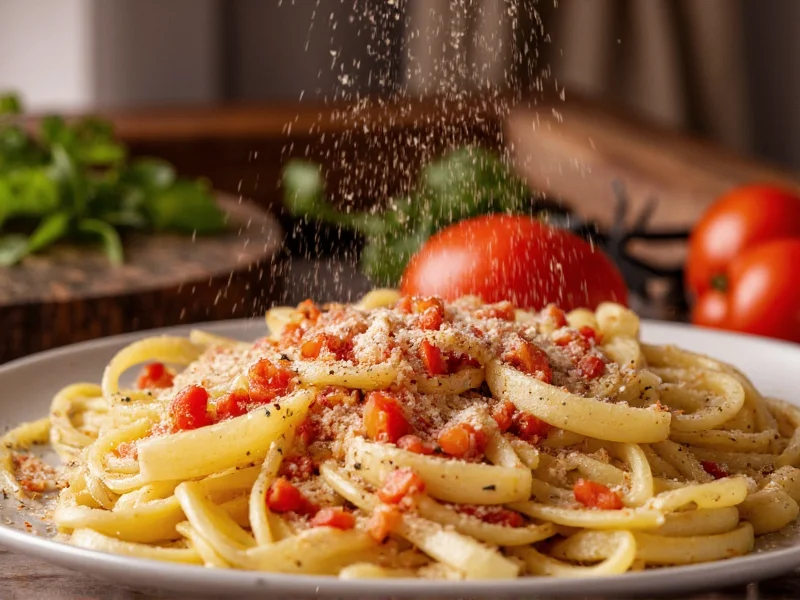Understanding how to properly describe seasoning techniques in Italian cooking helps both language learners and culinary enthusiasts recreate authentic dishes. The phrase ‘spolverato con’ literally translates to ‘dusted with’ and represents a fundamental finishing technique in Italian cuisine. Chefs use this method to add final flavor enhancements without overwhelming the dish’s natural ingredients.
Linguistic Breakdown of Italian Seasoning Terminology
The verb ‘spolverare’ means ‘to dust’ or ‘to sprinkle,’ making ‘spolverato con’ the perfect culinary term for describing the delicate application of seasonings. Unlike English which often uses ‘sprinkled,’ Italian cooking terminology emphasizes the light, even distribution implied by ‘dusting.’
When following traditional Italian recipes, you’ll encounter variations based on the specific seasoning:
| English Phrase | Italian Translation | Literally Translates To |
|---|---|---|
| Sprinkled with salt | Spolverato con sale | Dusted with salt |
| Sprinkled with pepper | Spolverato con pepe | Dusted with pepper |
| Sprinkled with herbs | Spolverato con erbe | Dusted with herbs |
| Sprinkled with cheese | Spolverato con formaggio | Dusted with cheese |
| Sprinkled with breadcrumbs | Spolverato con pangrattato | Dusted with breadcrumbs |
Culinary Context and Proper Usage
Italian cooking emphasizes restraint with seasonings, particularly during the finishing stage. The phrase ‘spolverato con’ typically appears in recipes after the main cooking process, indicating a final touch that enhances rather than dominates. This technique differs from seasoning during cooking (‘insaporito con’), which refers to building flavor foundations.
Consider these authentic usage examples:
- “Terminare il piatto spolverando con un po’ di prezzemolo fresco.” (Finish the dish by sprinkling with some fresh parsley.)
- “Spolverare la pasta con formaggio pecorino prima di servire.” (Sprinkle the pasta with pecorino cheese before serving.)
- “Dopo aver cotto la carne, spolverare con sale marino e pepe nero.” (After cooking the meat, sprinkle with sea salt and black pepper.)
Common Italian Seasonings for Sprinkling
Understanding which seasonings Italians typically apply as finishing touches helps use the ‘spolverato con’ phrase correctly. While salt and pepper form the foundation, regional variations exist across Italy’s diverse culinary landscape.
Popular finishing seasonings include:
- Fresh herbs like parsley (prezzemolo), basil (basilico), and oregano (origano)
- Finely grated cheeses such as Parmigiano-Reggiano or Pecorino Romano
- High-quality olive oil drizzled over finished dishes
- Sea salt flakes (fior di sale) for finishing
- Pepper freshly ground at the table
Regional Variations in Terminology
While ‘spolverato con’ remains standard across Italy, regional dialects sometimes influence how chefs describe seasoning techniques. In Southern Italy, you might hear ‘cospargere con’ (to scatter with) for more generous applications, while Northern chefs might use ‘insaporire con’ when referring to building flavor layers.
When translating recipes or cooking instructions, recognizing these subtle distinctions helps maintain authenticity. For instance, ‘cospargere con pangrattato’ suggests a more generous breadcrumb application than ‘spolverato con pangrattato,’ which implies a light dusting.
Avoiding Common Mistakes
Non-native speakers frequently make these errors when using Italian seasoning terminology:
- Using ‘sprinkled’ translations too literally instead of the culinary-specific ‘spolverato con’
- Over-seasoning dishes when Italian cuisine values restraint in finishing touches
- Mixing up when to use ‘spolverato con’ (finishing) versus ‘insaporito con’ (cooking process)
- Applying seasonings too early rather than as the final step before serving
Remember that authentic Italian cooking treats seasoning as an art form where timing and quantity significantly impact the final dish. The phrase ‘spolverato con’ specifically references that delicate final application that elevates rather than masks flavors.
Practical Application in Italian Cooking
When following traditional Italian recipes, watch for the phrase ‘spolverato con’ near the end of preparation instructions. This signals the critical finishing step where you should:
- Remove the dish from heat
- Apply seasonings gently and evenly
- Use minimal quantities to enhance rather than dominate
- Serve immediately to preserve the seasoning’s freshness
This technique preserves volatile flavor compounds in herbs and spices that would dissipate with additional cooking. Understanding how to properly ‘spolverare con’ transforms good dishes into authentic Italian culinary experiences.
FAQ
What’s the difference between ‘spolverato con’ and ‘insaporito con’ in Italian cooking?
‘Spolverato con’ refers specifically to the final dusting or sprinkling of seasonings just before serving, while ‘insaporito con’ describes seasonings added during the cooking process to build flavor foundations. The first creates a finishing touch, the second develops base flavors.
Can I use ‘sprinkled’ interchangeably with ‘spolverato con’ in Italian recipes?
No, ‘spolverato con’ carries specific culinary meaning in Italian that ‘sprinkled’ doesn’t fully capture. While ‘sprinkled’ is a general term, ‘spolverato con’ implies a light, even application as a finishing technique. Using the precise Italian terminology ensures proper technique execution.
Which Italian dishes most commonly use the ‘spolverato con’ technique?
Pasta dishes like Cacio e Pepe (spolverato con pepe), traditional risottos (spolverato con parmigiano), and grilled meats (spolverato con sale marino) frequently employ this finishing technique. Many Italian vegetable preparations also use this method, such as spolverato con pangrattato for baked vegetables.
Should I translate ‘spolverato con’ literally as ‘dusted with’ in English recipes?
While ‘dusted with’ is the literal translation, ‘sprinkled with’ works better in most English-language recipes. The key is conveying the light application technique rather than the exact wording. Many professional English recipe translations use ‘finished with’ or ‘topped with’ to capture the culinary intent.











 浙公网安备
33010002000092号
浙公网安备
33010002000092号 浙B2-20120091-4
浙B2-20120091-4